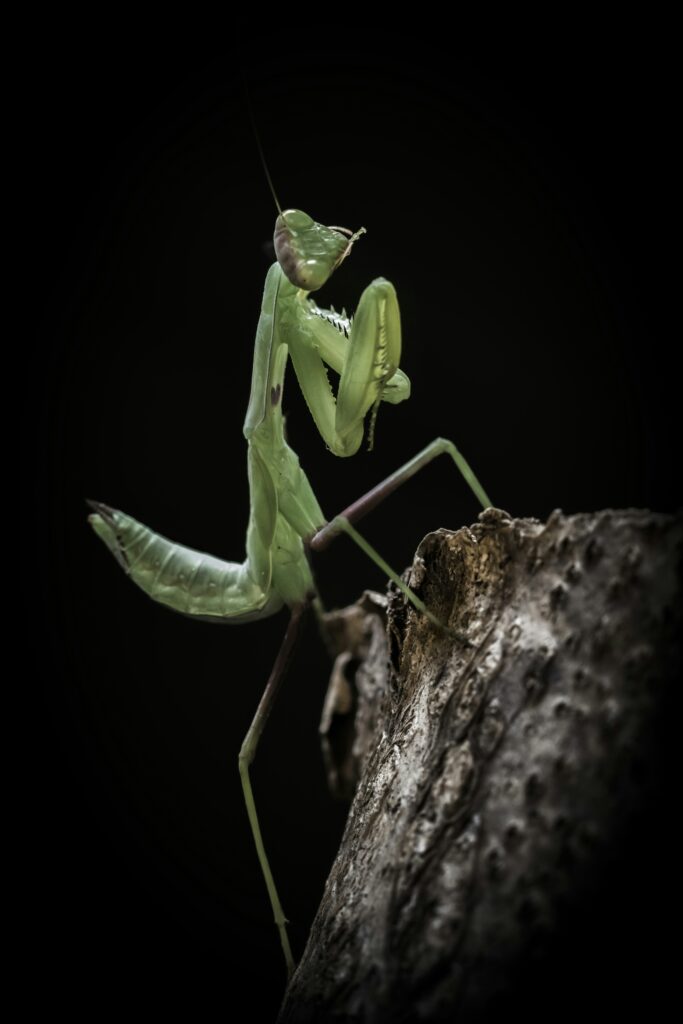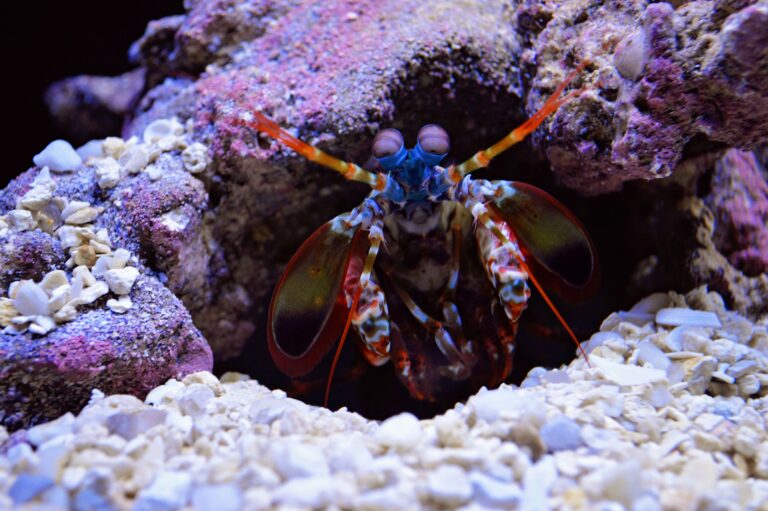In the depths of the ocean, there exists a creature that seems more like a fantastical creation from a science fiction novel than a real-life inhabitant of our planet. Meet the mantis shrimp, a fascinating marine crustacean known for its vibrant colors, powerful strikes, and extraordinary vision. In this blog post, we’ll delve into the curious case of the mantis shrimp, exploring its unique anatomy, incredible vision, hunting techniques, communication, and reproduction, as well as its impact on research and technology.
Anatomy of a Mantis Shrimp
Physical Appearance
The mantis shrimp, also known as stomatopods, are fascinating creatures renowned for their striking appearance. Typically, they have elongated bodies, divided into distinct segments, with vibrant coloration ranging from vivid greens to brilliant purples and blues. Their carapace, or shell, is hardened, providing protection for their vital organs. Mantis shrimp possess large, complex eyes situated on stalks, offering them excellent vision to detect prey and predators alike. These eyes are among the most complex in the animal kingdom, capable of perceiving ultraviolet light and polarized light, granting mantis shrimp a unique perspective of their environment.
Their appendages are equally remarkable, with two pairs of specialized claws, or raptorial appendages, located on their front. These claws are where the mantis shrimp’s power truly lies.
Powerful Claws and Hunting Techniques
Mantis shrimp are renowned for their incredibly powerful claws, which they employ both for hunting and defense. These claws come in two types: smashing and spearing. Smashing mantis shrimp have club-like appendages, while spearing mantis shrimp have spiky, spear-like claws.
When hunting, mantis shrimp utilize their claws with remarkable speed and force. Smashing mantis shrimp can deliver blows at speeds comparable to a .22 caliber bullet, exerting immense pressure upon impact. This allows them to crack open the hard shells of mollusks, crustaceans, and even small fish with astonishing ease. Spearing mantis shrimp, on the other hand, impale their prey with their sharp claws, immobilizing them for consumption.
In addition to their formidable hunting prowess, mantis shrimp also use their claws for defense. When threatened, they can deliver powerful strikes to fend off predators or competitors, inflicting significant damage.
Overall, the mantis shrimp’s anatomy, characterized by its vibrant colors, complex eyes, and powerful claws, reflects its role as a formidable predator in the marine ecosystem.
The Mantis Shrimp’s Vision
Extraordinary Vision System
The mantis shrimp boasts one of the most remarkable vision systems found in the animal kingdom. Their eyes are incredibly complex, surpassing even human vision in several aspects. Mantis shrimp have compound eyes that are capable of independently moving and focusing on different objects, providing them with exceptional visual acuity and depth perception. Each eye is divided into three regions, allowing them to perceive a wide field of view simultaneously.
Perception of Color and Polarized Light
One of the most fascinating aspects of mantis shrimp vision is their ability to perceive a vast range of colors, far beyond what humans can see. While humans have three types of color receptors (cones), allowing us to perceive red, green, and blue hues, mantis shrimp possess up to sixteen types of cones. This extensive array of photoreceptors enables them to discern a broad spectrum of colors, including ultraviolet light, which is invisible to humans.
In addition to their remarkable color vision, mantis shrimp can also detect polarized light. Polarization refers to the alignment of light waves in a specific direction. While most animals are unable to perceive polarized light, mantis shrimp possess specialized cells in their eyes that allow them to detect it. This unique ability aids them in various tasks, such as navigation, communication, and hunting.
The mantis shrimp’s extraordinary vision system plays a crucial role in their survival and behavior. Their ability to perceive colors and polarized light with such precision provides them with a distinct advantage in their underwater environment, allowing them to navigate effectively, communicate with conspecifics, and locate prey with remarkable accuracy.

Hunting Techniques
Description of Hunting Behaviors
Mantis shrimp are voracious predators, employing a variety of hunting techniques to capture their prey. Their hunting behaviors are characterized by speed, precision, and adaptability, making them formidable hunters in their marine habitats. One of the most notable features of mantis shrimp hunting is their use of specialized appendages known as raptorial claws, which they deploy with remarkable speed and force to incapacitate their prey.
Examples of Hunting Strategies and Prey
Mantis shrimp employ a diverse range of hunting strategies, depending on their species, habitat, and available prey. Smashing mantis shrimp, equipped with club-like claws, often ambush their prey by hiding in burrows or crevices, waiting for unsuspecting prey to venture close. When an opportunity arises, they strike with lightning-fast speed, delivering powerful blows to crack open the shells of crustaceans, mollusks, and even small fish.
Spearing mantis shrimp, on the other hand, utilize their sharp, spear-like claws to impale prey with remarkable precision. They may stalk their prey stealthily, waiting for the perfect moment to strike, or employ a more active hunting approach by actively pursuing prey in open water. Once within striking range, spearing mantis shrimp thrust their claws forward with astonishing speed, skewering their prey and immobilizing them instantly.
Mantis shrimp are opportunistic feeders, preying on a wide variety of marine organisms ranging from small crustaceans and mollusks to fish and even other mantis shrimp. Their hunting strategies are finely tuned to their environment and the behavior of their prey, allowing them to adapt and thrive in diverse marine ecosystems.
Overall, the hunting techniques of mantis shrimp showcase their remarkable adaptations and predatory prowess, highlighting their role as top predators in their underwater world.
VIDEO CREDITS NET GEO WILD
FAQs
Q. What is a mantis shrimp?
A. A mantis shrimp is a type of marine crustacean belonging to the order Stomatopoda. They are known for their vibrant colors and incredible hunting abilities.
Q. How many species of mantis shrimp are there?
A. There are around 400 species of mantis shrimp, divided into two main groups: smashers and spearers.
Q. Why are mantis shrimps called “nature’s technicolor boxers”?
A. Mantis shrimps are called “nature’s technicolor boxers” because of their colorful appearance and their powerful punching ability, which is one of the fastest movements in the animal kingdom.
Q. What is special about the eyes of mantis shrimps?
A. Mantis shrimps have some of the most complex eyes in the animal kingdom, with each eye capable of seeing polarized light and having three focal points.
Q. How do mantis shrimps hunt?
A. Mantis shrimps use their specialized claws to either smash or spear their prey, depending on their species. They can strike with incredible speed and force, stunning or killing their prey instantly.
Conclusion
From its rainbow-colored shell to its lightning-fast strikes, the mantis shrimp continues to captivate scientists and enthusiasts alike with its remarkable abilities. As we’ve seen, these creatures are not only marvels of nature but also sources of inspiration for technological advancements and scientific breakthroughs. By studying the mantis shrimp, we gain insights into the wonders of evolution and the endless possibilities for innovation. So let us continue to marvel at the technicolor boxers of the ocean and appreciate the beauty and complexity of the natural world.
UP NEXT
The Secret Lives of Octopuses: Intelligence and Problem Solving



